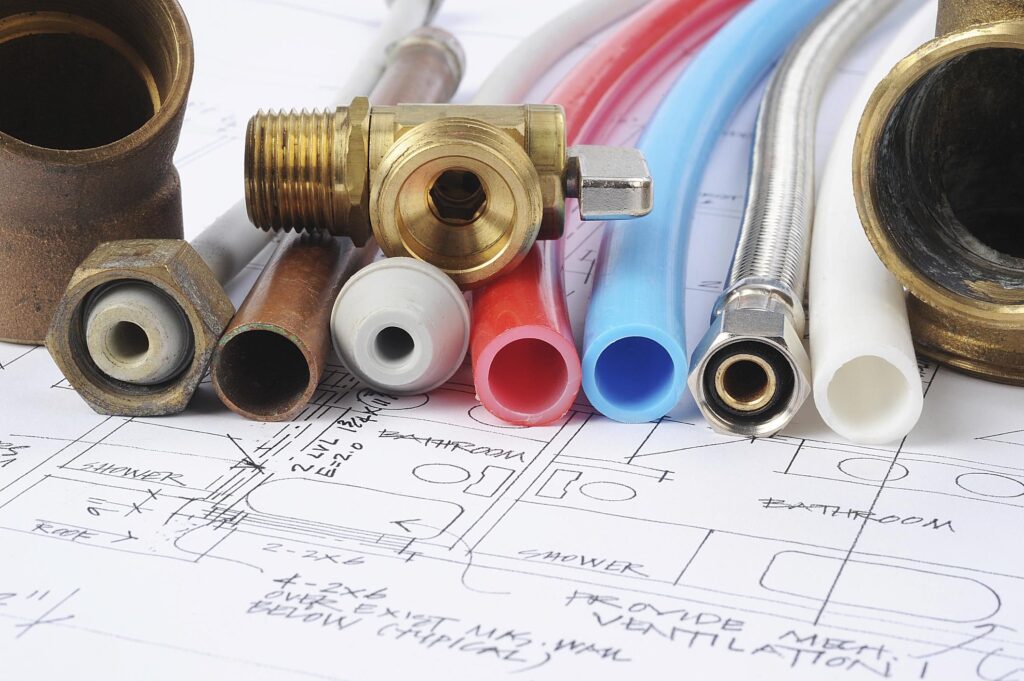
Has your plumber given you an estimate and is he mentioning all kinds of technical pipe names? We know it can be confusing because of the choices of several types of plumbing pipes used for water. Hopefully, this article on the main types of plumbing pipes used in residences will help explain better.
PVC pipes, aka Polyvinyl chloride pipes, are commonly used as part of a toilet, sink, or shower drain line. Its plastic tubing is ideal for this kind of usage because it protects the water from rust and corrosion better than other types of pipes. This capability also makes PVC pipes incredibly hearty. PVC pipes can last indefinitely unless they are subject to some form of damage.
PVC pipe is also able to handle higher water pressure. This is why they occasionally are used for residential home’s sprinkler lines. It is also a lighter-weight material, making it easier to work with than the more traditional galvanized steel piping options. PVC pipes contain a smooth inner lining as well, which protects against sediment buildup and makes them more resistant to blockages.
PEX or cross-linked polyethylene piping also refers to a plastic tubing commonly used for water supply lines. Like PVC piping, it prevents rust or corrosion from leaching into the water.
Plumbers like working with PEX pipes because they are flexible and easy to weave through tight spaces pipes live- such as walls, ceilings, basements, and attics. At the same time, they’re durable enough to withstand the pressures of your water supply. PEX pipe is also color-coded for hot and cold water, making it easy for plumbers to identify and organize when working on your house.
Pex has been proven to expand when frozen lines thaw, giving it an advantage over copper, which will usually burst.
Acrylonitrile butadiene styrene (ABS) pipe is similar to PVC pipes in nature but easy to identify based on their black color. ABS pipes are also particularly resilient to cold temperatures. It is predominantly used for drain and vent lines.
Though this kind of plumbing pipe is easy to install, it can warp when exposed to direct sunlight. ABS pipes are also noisier than other types of plumbing pipes, making noises some homeowners find disruptful.
ABS pipes are basically the older version of PVC pipes and are no longer recommended by plumbing codes. If you still have ABS pipes installed in your house then the best advice is to replace them with PVC pipes.
Copper pipe has been long been used for decades in the plumbing industry. This type of plumbing pipe can last 50 years plus and is commonly found in sinks, showers, tubs, and other fixtures in new and old homes. Copper pipes remain extremely popular amongst plumbers and homeowners alike because they are corrosion-resistant and best suited to protect the quality of the water. Rigid copper pipes are great for water supplies because they do not come with any health risks.
Copper pipes are able to handle high water pressure and are tolerant of both hot and cold water temperatures. It’s also able to be recycled, making it a somewhat friendly option for the environment.
That said, there are a few drawbacks to consider. Because it is so rigid, plumbers cannot use copper piping in tight spaces. It is also the most expensive type of plumbing pipe. As the price of copper continues to rise, so will the costs of any project involving copper pipe.
Another factor to consider in the application of copper piping is that it must be soldered together. This may also require some additional fittings. Since not all plumbers can solder the plumbing pipes adeptly, you must always hire reputable plumbers in North, TX to perform the job.
Cast iron pipe and galvanized steel pipe are rarely included in new residential applications, though they are commonly found in older homes. Cast iron pipes were typically used as sewer pipes or for other drainage purposes. Their popularity largely stemmed from the fact that they are heat-resistant and reduce the sound of moving water.
Galvanized pipes were once one of the standard plumbing pipes in residential projects. However, now these pipes are not used frequently as they have poor corrosion resistance. The rust builds up easily, especially in small diameter pipes. If you have had an old galvanized pipe in your home, then you must have seen water coming from it with rust traces. This happens when the scale inside the pipe breaks. The best application of galvanized pipes these days is the transportation of non-portable water or greywater.
A huge con for both these pipes is the rust and corrosion. Over time, this will affect their ability to maintain a clean water supply. These types of pipes have largely been replaced by copper or PEX pipes in residential plumbing repairs.
The bottom line, there are many types of plumbing pipes available in the market. When you replace a plumbing pipe in your house, your best bet is to call the professionals. Auger Pros Plumbing’s team of professionals is well-versed in handling the most complex plumbing issues. Call today! 214-206-6580.